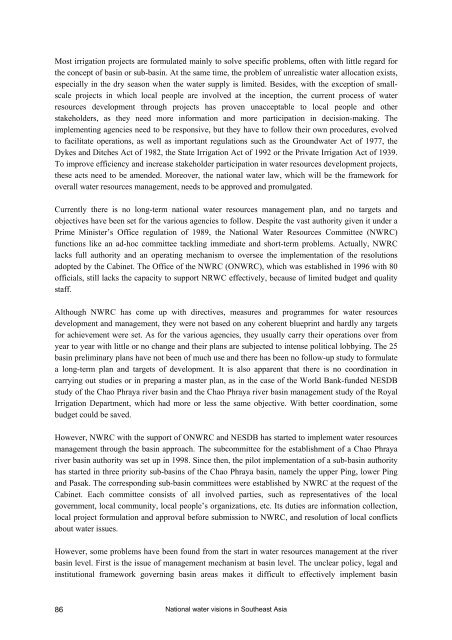The FAO-ESCAP pilot project on national water visions. From vision ...
The FAO-ESCAP pilot project on national water visions. From vision ...
The FAO-ESCAP pilot project on national water visions. From vision ...
You also want an ePaper? Increase the reach of your titles
YUMPU automatically turns print PDFs into web optimized ePapers that Google loves.
Most irrigati<strong>on</strong> <str<strong>on</strong>g>project</str<strong>on</strong>g>s are formulated mainly to solve specific problems, often with little regard for<br />
the c<strong>on</strong>cept of basin or sub-basin. At the same time, the problem of unrealistic <strong>water</strong> allocati<strong>on</strong> exists,<br />
especially in the dry seas<strong>on</strong> when the <strong>water</strong> supply is limited. Besides, with the excepti<strong>on</strong> of smallscale<br />
<str<strong>on</strong>g>project</str<strong>on</strong>g>s in which local people are involved at the incepti<strong>on</strong>, the current process of <strong>water</strong><br />
resources development through <str<strong>on</strong>g>project</str<strong>on</strong>g>s has proven unacceptable to local people and other<br />
stakeholders, as they need more informati<strong>on</strong> and more participati<strong>on</strong> in decisi<strong>on</strong>-making. <str<strong>on</strong>g>The</str<strong>on</strong>g><br />
implementing agencies need to be resp<strong>on</strong>sive, but they have to follow their own procedures, evolved<br />
to facilitate operati<strong>on</strong>s, as well as important regulati<strong>on</strong>s such as the Ground<strong>water</strong> Act of 1977, the<br />
Dykes and Ditches Act of 1982, the State Irrigati<strong>on</strong> Act of 1992 or the Private Irrigati<strong>on</strong> Act of 1939.<br />
To improve efficiency and increase stakeholder participati<strong>on</strong> in <strong>water</strong> resources development <str<strong>on</strong>g>project</str<strong>on</strong>g>s,<br />
these acts need to be amended. Moreover, the nati<strong>on</strong>al <strong>water</strong> law, which will be the framework for<br />
overall <strong>water</strong> resources management, needs to be approved and promulgated.<br />
Currently there is no l<strong>on</strong>g-term nati<strong>on</strong>al <strong>water</strong> resources management plan, and no targets and<br />
objectives have been set for the various agencies to follow. Despite the vast authority given it under a<br />
Prime Minister’s Office regulati<strong>on</strong> of 1989, the Nati<strong>on</strong>al Water Resources Committee (NWRC)<br />
functi<strong>on</strong>s like an ad-hoc committee tackling immediate and short-term problems. Actually, NWRC<br />
lacks full authority and an operating mechanism to oversee the implementati<strong>on</strong> of the resoluti<strong>on</strong>s<br />
adopted by the Cabinet. <str<strong>on</strong>g>The</str<strong>on</strong>g> Office of the NWRC (ONWRC), which was established in 1996 with 80<br />
officials, still lacks the capacity to support NRWC effectively, because of limited budget and quality<br />
staff.<br />
Although NWRC has come up with directives, measures and programmes for <strong>water</strong> resources<br />
development and management, they were not based <strong>on</strong> any coherent blueprint and hardly any targets<br />
for achievement were set. As for the various agencies, they usually carry their operati<strong>on</strong>s over from<br />
year to year with little or no change and their plans are subjected to intense political lobbying. <str<strong>on</strong>g>The</str<strong>on</strong>g> 25<br />
basin preliminary plans have not been of much use and there has been no follow-up study to formulate<br />
a l<strong>on</strong>g-term plan and targets of development. It is also apparent that there is no coordinati<strong>on</strong> in<br />
carrying out studies or in preparing a master plan, as in the case of the World Bank-funded NESDB<br />
study of the Chao Phraya river basin and the Chao Phraya river basin management study of the Royal<br />
Irrigati<strong>on</strong> Department, which had more or less the same objective. With better coordinati<strong>on</strong>, some<br />
budget could be saved.<br />
However, NWRC with the support of ONWRC and NESDB has started to implement <strong>water</strong> resources<br />
management through the basin approach. <str<strong>on</strong>g>The</str<strong>on</strong>g> subcommittee for the establishment of a Chao Phraya<br />
river basin authority was set up in 1998. Since then, the <str<strong>on</strong>g>pilot</str<strong>on</strong>g> implementati<strong>on</strong> of a sub-basin authority<br />
has started in three priority sub-basins of the Chao Phraya basin, namely the upper Ping, lower Ping<br />
and Pasak. <str<strong>on</strong>g>The</str<strong>on</strong>g> corresp<strong>on</strong>ding sub-basin committees were established by NWRC at the request of the<br />
Cabinet. Each committee c<strong>on</strong>sists of all involved parties, such as representatives of the local<br />
government, local community, local people’s organizati<strong>on</strong>s, etc. Its duties are informati<strong>on</strong> collecti<strong>on</strong>,<br />
local <str<strong>on</strong>g>project</str<strong>on</strong>g> formulati<strong>on</strong> and approval before submissi<strong>on</strong> to NWRC, and resoluti<strong>on</strong> of local c<strong>on</strong>flicts<br />
about <strong>water</strong> issues.<br />
However, some problems have been found from the start in <strong>water</strong> resources management at the river<br />
basin level. First is the issue of management mechanism at basin level. <str<strong>on</strong>g>The</str<strong>on</strong>g> unclear policy, legal and<br />
instituti<strong>on</strong>al framework governing basin areas makes it difficult to effectively implement basin<br />
86<br />
Nati<strong>on</strong>al <strong>water</strong> visi<strong>on</strong>s in Southeast Asia
















